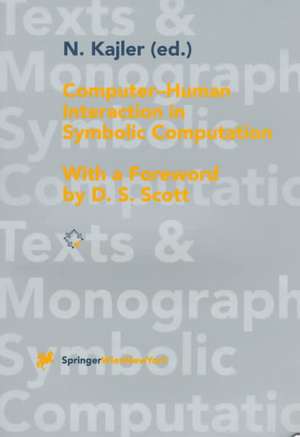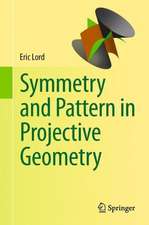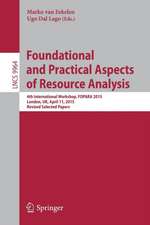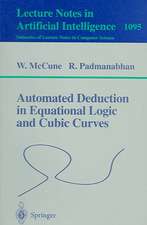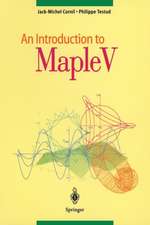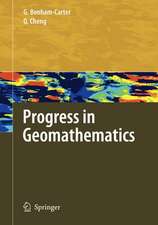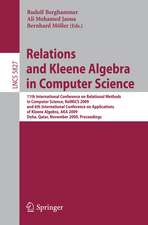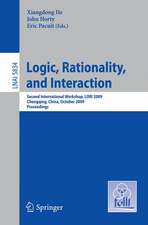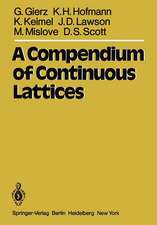Computer - Human Interaction in Symbolic Computation: Texts & Monographs in Symbolic Computation
Editat de Norbert Kajler Cuvânt înainte de D. S. Scotten Limba Engleză Paperback – 10 iun 1998
Din seria Texts & Monographs in Symbolic Computation
-
 Preț: 393.52 lei
Preț: 393.52 lei - 15%
 Preț: 640.71 lei
Preț: 640.71 lei - 20%
 Preț: 335.18 lei
Preț: 335.18 lei - 20%
 Preț: 644.48 lei
Preț: 644.48 lei - 15%
 Preț: 640.06 lei
Preț: 640.06 lei - 20%
 Preț: 929.74 lei
Preț: 929.74 lei - 15%
 Preț: 643.34 lei
Preț: 643.34 lei - 15%
 Preț: 469.55 lei
Preț: 469.55 lei - 20%
 Preț: 591.17 lei
Preț: 591.17 lei - 15%
 Preț: 653.14 lei
Preț: 653.14 lei - 20%
 Preț: 348.89 lei
Preț: 348.89 lei - 20%
 Preț: 343.44 lei
Preț: 343.44 lei - 20%
 Preț: 341.30 lei
Preț: 341.30 lei - 20%
 Preț: 1160.88 lei
Preț: 1160.88 lei - 15%
 Preț: 702.24 lei
Preț: 702.24 lei - 20%
 Preț: 1460.04 lei
Preț: 1460.04 lei - 20%
 Preț: 652.07 lei
Preț: 652.07 lei - 18%
 Preț: 896.84 lei
Preț: 896.84 lei - 18%
 Preț: 1011.45 lei
Preț: 1011.45 lei - 15%
 Preț: 489.36 lei
Preț: 489.36 lei - 20%
 Preț: 1158.76 lei
Preț: 1158.76 lei - 20%
 Preț: 508.94 lei
Preț: 508.94 lei
Preț: 642.33 lei
Preț vechi: 802.90 lei
-20% Nou
Puncte Express: 963
Preț estimativ în valută:
122.92€ • 133.48$ • 103.26£
122.92€ • 133.48$ • 103.26£
Carte tipărită la comandă
Livrare economică 22 aprilie-06 mai
Preluare comenzi: 021 569.72.76
Specificații
ISBN-13: 9783211828434
ISBN-10: 3211828435
Pagini: 232
Ilustrații: XI, 212 p.
Dimensiuni: 155 x 235 x 12 mm
Greutate: 0.33 kg
Ediția:Softcover reprint of the original 1st ed. 1998
Editura: SPRINGER VIENNA
Colecția Springer
Seria Texts & Monographs in Symbolic Computation
Locul publicării:Vienna, Austria
ISBN-10: 3211828435
Pagini: 232
Ilustrații: XI, 212 p.
Dimensiuni: 155 x 235 x 12 mm
Greutate: 0.33 kg
Ediția:Softcover reprint of the original 1st ed. 1998
Editura: SPRINGER VIENNA
Colecția Springer
Seria Texts & Monographs in Symbolic Computation
Locul publicării:Vienna, Austria
Public țintă
ResearchCuprins
The ACELA project: aims and plans.- 1 Introduction.- 2 Interactive books.- 3 Interactive mathematical books.- 4 Architecture.- 5 The content of the book.- 6 Related work.- 7 Conclusion.- References.- Active structured documents as user interfaces.- 1 Introduction.- 2 Limitations of graphical user interface toolkits.- 3 Active and structured documents.- 4 The Grif editing toolkit.- 5 Applications based on active structured documents.- 6 Related work.- 7 Conclusion.- References.- Direct manipulation in a mathematics user interface.- 1 Introduction.- 2 Previous work.- 3 Design overview.- 4 Overview of static interface elements.- 5 Direct manipulation.- 6 Usability.- 7 Interval arithmetic.- 8 Implementation details.- 9 Directions for future work.- 10 Conclusion.- References.- Successful pedagogical applications of symbolic computation.- 1 Introduction.- 2 Symbolic computation and pedagogy.- 3 The EPGY course software.- 4 User interface and design issues.- 5 Logical structure of a derivation.- 6 Two examples.- 7 What is gained.- 8 Limitations and desiderata.- 9 Final remarks.- References.- Design principles of Mathpert: software to support education in algebra and calculus.- 1 Introduction.- 2 Purposes of software for mathematics education.- 3 Design principles.- 4 Cognitive fidelity and glass box in Mathpert: operations and pedagogy.- 5 Customizing the solution in Mathpert.- 6 The correctness principle in Mathpert.- 7 Using the computer’s power when the user is stuck.- 8 Traditional interface issues: ease of use.- 9 Interfaces and pedagogy.- 10 Use and availability of Mathpert.- References.- Hypermedia learning environment for mathematical sciences.- 1 Introduction.- 2 Related work in the field.- 3 Components of mathematical hypermedia.- 4 Designing mathematicalhypermedia.- 5 Structure of the hypermedia database.- 6 Learning interface.- 7 Conclusion and research topics.- References.- Chains of recurrences for functions of two variables and their application to surface plotting.- 1 Introduction.- 2 Chains of recurrences for functions of one variable.- 3 Chains of recurrences for functions of two variables.- 4 A Maxima/IZIC implementation.- 5 Conclusions and future work.- 6 Availability.- References.- Algorithm animation with Agat.- 1 Introduction.- 2 Overview of Agat.- 3 Using Agat.- 4 The Agat language.- 5 The graphical features of Agat.- 6 Some applications of Agat.- 7 Implementation.- 8 Conclusion.- References.- Computation Computation and images in combinatorics.- 1 Introduction.- 2 Overview of CalICo.- 3 The use of CalICO as illustrated by examples.- 4 The tutor.- 5 Formal coding and symbolic computation.- 6 Graphical workshops and graphical interfaces.- 7 Communication manager.- 8 Availability and implementation.- 9 Conclusion.- References.
Caracteristici
The presented research material helps to create ever-more powerful and user-friendly applications.
